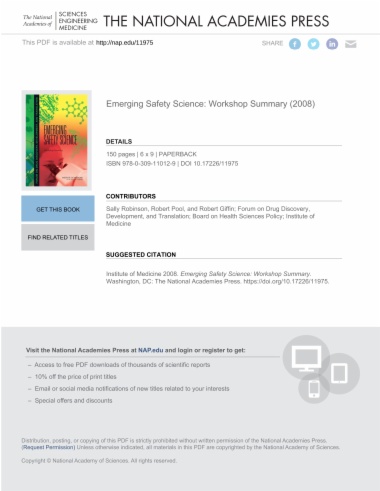In recent years, the costs of new drug development have skyrocketed. The average cost of developing a new approved drug is now estimated to be $1.3 billion (DiMasi and Grabowski, 2007). At the same time, each year fewer new molecular entities (NMEs) are approved. DiMasi and Grabowski report that only 21.5 percent of the candidate drugs that enter phase I clinical testing actually make it to market. In 2007, just 17 novel drugs and 2 novel biologics were approved. In addition to the slowing rate of drug development and approval, recent years have seen a number of drugs withdrawn from the market for safety reasons. According to the Government Accountability Office (GAO), 10 drugs were withdrawn because of safety concerns between 2000 and March 2006 (GAO, 2006). Finding ways to select successful drug candidates earlier in development could save millions or even billions of dollars, reduce the costs of drugs on the market, and increase the number of new drugs with improved safety profiles that are available to patients.
Emerging scientific knowledge and technologies hold the potential to enhance correct decision making for the advancement of candidate drugs. Identification of safety problems is a key reason that new drug development is stalled. Traditional methods for assessing a drug's safety prior to approval are limited in their ability to detect rare safety problems. Prior to receiving U.S. Food and Drug Administration (FDA) approval, a drug will have been tested in hundreds to thousands of patients. Generally, drugs cannot confidently be linked to safety problems until they have been tested in tens of thousands to hundreds of thousands of people. With current methods, it is unlikely that rare safety problems will be identified prior to approval.
Emerging Safety Science: Workshop Summary summarizes the events and presentations of the workshop.
- Cover
- Front Matter
- 1 Introduction
- 2 Investigative Toxicology: The State of the Art
- 3 Screening Technologies I: Human Cell–Based Approaches
- 4 Screening Technologies II: Toxicogenomics
- 5 Screening Technologies III: Metabolomics
- 6 Screening Technologies IV: Pharmacogenetics
- 7 Qualifying Biomarkers
- 8 Pharmacovigilance
- 9 Integration
- 10 The Future of Safety Science
- References
- Appendix A: Workshop Agenda
- Appendix B: Speaker Biographies

